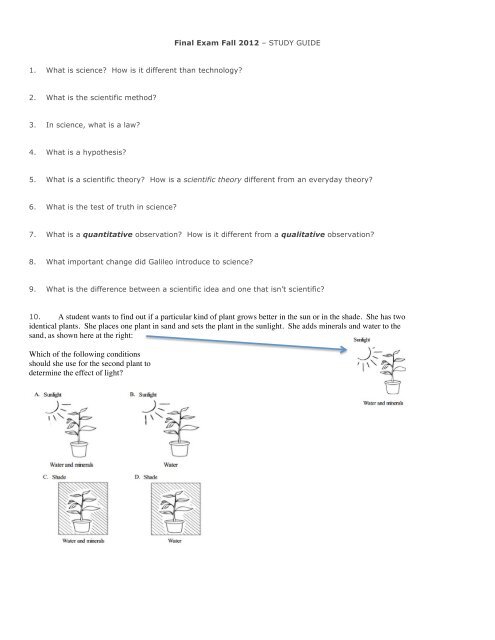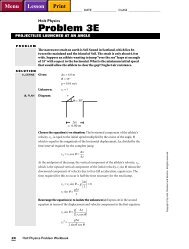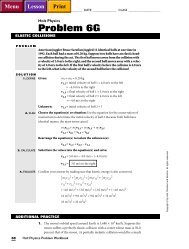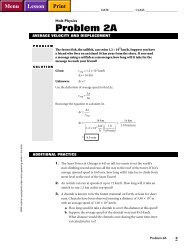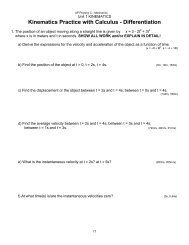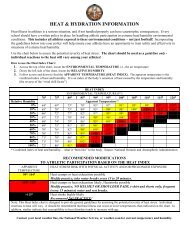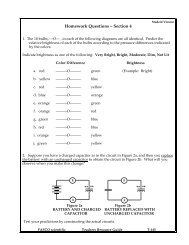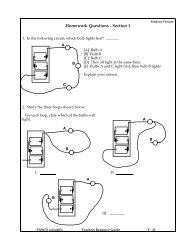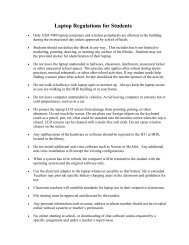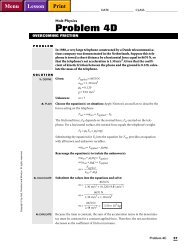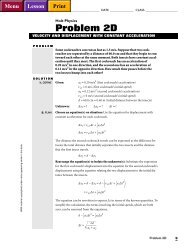Final Exam Study Guide, all questions - Hays High School
Final Exam Study Guide, all questions - Hays High School
Final Exam Study Guide, all questions - Hays High School
You also want an ePaper? Increase the reach of your titles
YUMPU automatically turns print PDFs into web optimized ePapers that Google loves.
<strong>Final</strong> <strong>Exam</strong> F<strong>all</strong> 2012 – STUDY GUIDE<br />
1. What is science? How is it different than technology?<br />
2. What is the scientific method?<br />
3. In science, what is a law?<br />
4. What is a hypothesis?<br />
5. What is a scientific theory? How is a scientific theory different from an everyday theory?<br />
6. What is the test of truth in science?<br />
7. What is a quantitative observation? How is it different from a qualitative observation?<br />
8. What important change did Galileo introduce to science?<br />
9. What is the difference between a scientific idea and one that isn’t scientific?<br />
10. A student wants to find out if a particular kind of plant grows better in the sun or in the shade. She has two<br />
identical plants. She places one plant in sand and sets the plant in the sunlight. She adds minerals and water to the<br />
sand, as shown here at the right:<br />
Which of the following conditions<br />
should she use for the second plant to<br />
determine the effect of light?
11. A group of students is making paper airplanes. They think that the kind of paper and the design of<br />
the airplane may affect how far each paper airplane flies. The students test first to see if the kind of<br />
paper affects how far the airplane flies. They make several airplanes out of different kinds of paper,<br />
using the same design. Why is it important that <strong>all</strong> the planes have the same design?<br />
12. Students have a sm<strong>all</strong> steel b<strong>all</strong> and a large steel b<strong>all</strong>, and they have a short ramp and a t<strong>all</strong> ramp. The students<br />
want to find out if a b<strong>all</strong>’s size affects how far it can roll. What is the independent variable in this experiment? What is<br />
the dependent variable? What will need to remain the same?<br />
13. A swimming team wants to select one of three fabrics for their new swimsuits. Each fabric is made of a different<br />
material. The team decides to do the following experiment:<br />
They cut the same size pieces from each fabric and wet each piece with the same amount of water. They<br />
hang the pieces in the sunlight and they check every two minutes to see if any of the pieces are dry.<br />
What can the team find out about the different fabrics from doing just this experiment?<br />
14. A swimming team wants to select one of three fabrics for their new swimsuits. Each fabric is made of a different<br />
material. The team decides to do the following experiment:<br />
They cut the same size pieces from each fabric and wet each piece with the same amount of water. They<br />
hang the pieces in the sunlight and they check every two minutes to see if any of the pieces are dry.<br />
A. What is the independent variable in this experiment?<br />
B. The dependent variable?<br />
C. What is staying the same?<br />
15. A student wants to buy a new skateboard. He wants to find out if the size of the wheels affects how far he can<br />
coast on the skateboard. He also wants to find out if the type of material the board is made of affects how far he can<br />
coast on the skateboard.<br />
He decides to compare two skateboard models that are the same size but are made of different materials and have<br />
different size wheels.<br />
He pushes off as hard as he can and stands on the skateboard until<br />
the skateboard comes to a stop. He tries each skateboard 5 times to<br />
see how far he can go. He uses the same pavement and the same<br />
starting point for <strong>all</strong> the trials.<br />
He finds out that he can coast farther with Model 1.<br />
What can he conclude from this test?<br />
16. What is inertia?<br />
17. A girl pushes a cart to the right with a 10 N force. A boy pushes it to the right with a 2 N force. What is the net<br />
force on the cart?<br />
18. What is tension force, where is it found, and in what direction does it act?<br />
19. What is the net force on any object in equilibrium?
20. What is the difference between speed and velocity?<br />
21. What is meant by the term, “net force?”<br />
22. Why do objects have weight? On what two things does weight depend?<br />
23. How do you move in front of a motion detector to make a line that slants upward?<br />
24. What does the slope of a velocity v. time graph tell you? What does the slope of a position v. time graph tell<br />
you?<br />
25. Sketch a position-time graph of two objects, where<br />
one object starts behind the other one. One object should<br />
be moving away from the detector at a constant speed,<br />
and the other object should not be moving.<br />
26. Sketch a position-time graph of two objects, traveling<br />
at the same speed, where one object starts behind the<br />
other one.<br />
27. Sketch a position-time graph for two objects that start<br />
at the same place. One travels away from the detector at<br />
a fast constant speed. The other travels away from the<br />
detector at a slower constant speed.<br />
28. Sketch a position-time graph for two objects that<br />
shows one object holding still while the other moves away<br />
from the detector at a moderate constant speed.<br />
29. Sketch a position-time graph for two objects. Object<br />
1 moves away from the detector at a fast constant speed.<br />
Object 2 moves toward the detector at a slow constant<br />
speed.<br />
30. Sketch a position-time graph for two objects that start<br />
at different places, and move away from the detector at<br />
the same constant speed.<br />
31. Draw the forces acting on the object for each of the following situations:<br />
A. A book f<strong>all</strong>ing off a table.<br />
B. A skydiver f<strong>all</strong>ing through the sky.<br />
C. A soccer b<strong>all</strong> after it has been hit straight up into the air.<br />
D. A leaf floating to the ground.<br />
32. Draw the forces acting on the book for each of the following situations:<br />
A. A book sliding across the table at a constant speed.<br />
B. A book sliding across the table at a constant acceleration.<br />
C. A book sliding across the table slowing to a stop.<br />
D. A book motionless on the table.
33. Draw the forces acting on the backpack for each of the following situations:<br />
A. A backpack f<strong>all</strong>ing off a table.<br />
B. A backpack being lifted off a table.<br />
C. A backpack being placed on a table.<br />
D. A backpack hanging over a student's shoulder.<br />
34. Suppose you are in a car that is going around a curve. The speedometer reads a constant 30 mi/h.<br />
A. Is your speed changing?<br />
a. If so, how?<br />
B. Is your velocity changing?<br />
a. If so, how?<br />
35. What must be true about the forces acting on an object when the object is in equilibrium?<br />
36. A car is parked on a hill. In order to keep the car from rolling downhill, how big is the friction force compared to<br />
the force trying to make the car go downhill?<br />
37. A 1 N force and a 3 N force act on an object in opposite directions. What is the net force on the object?<br />
38. The acceleration produced by a net force on an object is _____ proportional to the mass of the object. The<br />
acceleration produced by a net force is _____ proportional to the size of the net force. The acceleration points in the<br />
_____ direction as the net force.<br />
.<br />
39. What is true about the force or forces acting on an object that is in free f<strong>all</strong>?<br />
40. About how fast will a b<strong>all</strong> be moving if it has dropped for 4 seconds in free f<strong>all</strong>?<br />
41. A light b<strong>all</strong> and heavy b<strong>all</strong> the same size are dropped at the same time. In free f<strong>all</strong>, which b<strong>all</strong> hits the ground<br />
first?<br />
42. A light b<strong>all</strong> and heavy b<strong>all</strong> the same size are dropped at the same time. In air, which b<strong>all</strong> hits the ground first?<br />
43. What is the “terminal velocity” of an object?<br />
44. A car is moving at a constant velocity to the right on a rough surface. Sketch <strong>all</strong> of the forces acting on the car.<br />
45. Draw a set of marks that represents where the car will be every second for 5 seconds if it's traveling at a<br />
constant velocity.
46. How many forces are involved in an interaction?<br />
47. Your friend says that action-reaction pairs of forces cancel each other out because they’re equal and opposite.<br />
She’s wrong, and how do you correct her?<br />
48. Which pulls harder – the Sun on Earth, or Earth on the Sun?<br />
49. Sketch <strong>all</strong> of the forces acting on an apple as it rests in your hand.<br />
50. You kick a soccer b<strong>all</strong> with 500 N of force. How much force is exerted by the soccer b<strong>all</strong> on your foot?<br />
51. At the beginning of the movie, “Men in Black,” a giant luna moth smashes into the windshield of the truck<br />
carrying the alien. Which hit with more force: the moth against the windshield, or the windshield against the moth?<br />
52. At the beginning of the movie, “Men in Black,” a giant luna moth smashes into the windshield of the truck<br />
carrying the alien. Which accelerated more as a result, the moth or the truck?<br />
53. Gravity pulls downward on a book placed on a table. Why does the book remain at rest?<br />
54. When a Great Dane is tied to a tree there are forces on the Great Dane, tree, and ground. What force must be<br />
the greatest to get the system to move?<br />
A. Great Dane’s pull on the tree<br />
B. Great Dane’s push against the ground<br />
C. tree's pull on the Great Dane<br />
55. Which force is greater: a bat hitting the b<strong>all</strong>, or the b<strong>all</strong> hitting the bat?<br />
56. Which force is larger at the tug-of-war: the seniors pulling against the freshmen, or the freshmen pulling against<br />
the seniors?<br />
57. In an action-reaction pair, which force is larger: the action or the reaction?<br />
58. A fat turtle and a skinny hare reach the finish line at the same speed. Which has more momentum?<br />
59. When BOTH the force and time of contact are tripled (x3), what happens to the impulse?<br />
60. A wrestler f<strong>all</strong>s and must stop by hitting either the squishy mat or the hard concrete floor. Which will change his<br />
momentum more? Why?<br />
61. A wrestler f<strong>all</strong>s and must stop by hitting either the squishy mat or the hard concrete floor. Which will give him<br />
more impulse? Why?<br />
62. A wrestler f<strong>all</strong>s and must stop by hitting either the squishy mat or the hard concrete floor. Which will exert more<br />
force on him? Why?<br />
63. A wrestler f<strong>all</strong>s and must stop by hitting either the squishy mat or the hard concrete floor. Which will take more<br />
time?
64. Give an example of (a) an inelastic collision and (b) an elastic collision.<br />
65. You’re a skateboard expert. You swoop by and pick up your physics textbook to study as you relax. After you<br />
pick up the book, how fast are you moving compared to your speed before you picked up the book?<br />
66. You’re a skateboard expert. You swoop by and pick up your physics textbook to study as you relax. After you<br />
pick up the book, how much momentum do (you + book) have compared to just your momentum before you picked<br />
up the book?<br />
67. Why do you feel less stopping force when f<strong>all</strong>ing into a net rather than a rigid surface?<br />
68. Tony, Christopher and "Walnuts" each shoot their guns at three identical blocks of wood. Tony’s bullet hits a<br />
block of wood that moves away slowly. Christopher’s bullet hits a block of wood that moves away a little bit faster.<br />
“Walnuts’” bullet hits a block of wood that moves away re<strong>all</strong>y fast. Which block of wood has the most momentum<br />
after being shot?


